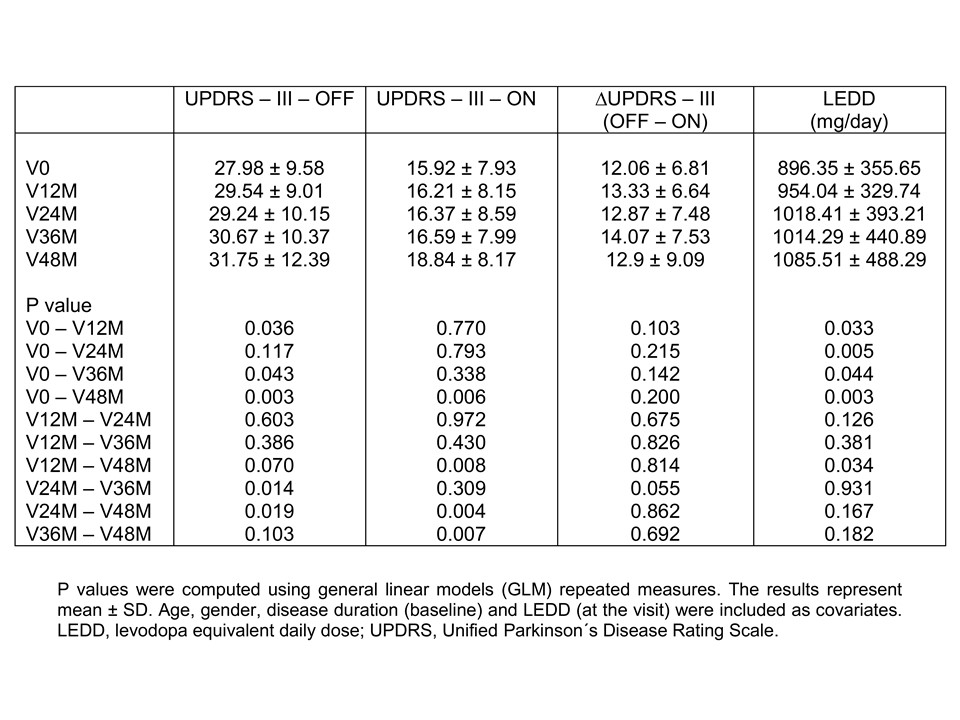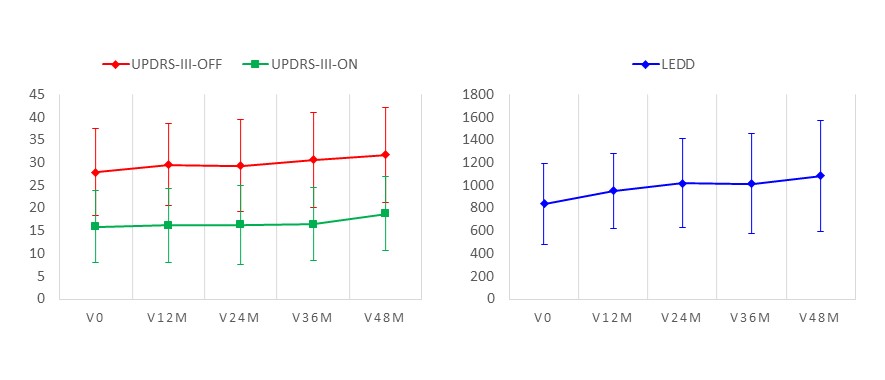Objective: The aim of the present study was to analyze the response to levodopa in Parkinson´s disease (PD) patients with motor fluctuations followed up for 4 years.
Background: A good response to levodopa is a key factor to indicate a device-aided therapies (DATs) in PD. A loss of response may contraindicate previously indicated DATs, this being particularly important in deep brain stimulation (DBS) since there is often long waiting lists.
Method: PD patients with motor fluctuations recruited from January/2016 to November/2017 from the COPPADIS cohort [1,2] and assessed annually during the OFF and ON states were included in this analysis. At each visit (V0, baseline; V12M, at 12 ± 1 month; V24M, at 24 ± 1 month; V36M, at 36 ± 2 months; V48M, at 48 ± 2 months), the Unified Parkinson´s Disease Rating Scale – part III (UPDRS-III) was applied during the OFF state (without medication during the last 12 hours) and during the ON state. General linear model repeated measures were used to test for changes in the mean UPDRS-III-OFF, UPDRS-III-ON and ∆UPDRS-III (UPDRS-III-OFF – UPDRS-III-ON) between visits. Levodopa equivalent daily dose (LEDD) was included as covariate.
Results: Sixty-three patients (63.94 ± 8.42 years old; 68.3% males) were included. Mean disease duration was 7.81 ± 3.64 years. From V0 to V48M, a significant increase in both the UPDRS-III-OFF (from 27.98 ± 9.58 to 31.75 ± 12.39; p=0.003) and in the UPDRS-III-ON (from 15.92 ± 7.93 to 18.84 ± 8.17; p=0.006) was observed despite the significant increase in the LEDD (from 896.35 ± 355.65 to 1085.51 ± 488.29; p=0.003). However, no significant differences (p value > 0.05 for all possible combinations) were detected between visits in the ∆UPDRS-III (Table 1 and Figure 1). The mean percentage of improvement from the OFF to the ON state was 43.26 ± 19.62, 45.02 ± 21.66, 44.34 ± 20.18, 45.53 ± 17.64 and 38.4 ± 17.98 at V0, V12M, V24M, V36M and V48M, respectively.
Conclusion: In this cohort of PD patients with motor fluctuations, the response to levodopa did not impair after a 4-year follow-up. This finding could be relevant in PD patients waiting to start with DATs (e.g., DBS) regarding motor response to dopaminergic medication.
References: 1. Santos-García D, Mir P, Cubo E, et al.; COPPADIS Study Group. COPPADIS-2015 (COhort of Patients with PArkinson’s DIsease in Spain, 2015), a global–clinical evaluations, serum biomarkers, genetic studies and neuroimaging–prospective, multicenter, non-interventional, long-term study on Parkinson’s disease progression. BMC Neurol 2016;16:26.
2. Santos García D, Jesús S, Aguilar M, et al.; COPPADIS Study Group. COPPADIS-2015 (COhort of Patients with PArkinson’s DIsease in Spain, 2015): an ongoing global Parkinson’s disease project about disease progression with more than 1000 subjects included. Results from the baseline evaluation. Eur J Neurol 2019;26:1399-1407.
To cite this abstract in AMA style:
D. Santos García, T. de Deus, C. Cores, M. Feal Painceiras, I. García-Díaz, M. íñiguez, J. Paz González, S. Jesús, M. Cosgaya, J. García Caldentey, N. Caballol, I. Legarda, J. Hernández Vara, I. Cabo, L. López Manzanares, I. González Aramburu, M. Avila, V. Gómez Mayordomo, V. Nogueira, J. Dotor, C. Borrué, B. Solano, M. álvarez Sauco, L. Vela, F. Escalante, E. Cubo, Z. Mendoza, J. Martínez Castrillo, P. Sánchez Alonso, M. Alonso Losada, N. López Ariztegui, M. Gastón, J. Kulisevsky, M. Seijo, C. Valero, R. Alonso Redondo, M. Buongiorno, C. Ordás, P. Martínez Martín, P. Mir, C. Coppadis. Response to Levodopa in Parkinson´s Disease Over Time. A 4-year Follow-up Study. [abstract]. Mov Disord. 2023; 38 (suppl 1). https://www.mdsabstracts.org/abstract/response-to-levodopa-in-parkinsons-disease-over-time-a-4-year-follow-up-study/. Accessed December 16, 2025.« Back to 2023 International Congress
MDS Abstracts - https://www.mdsabstracts.org/abstract/response-to-levodopa-in-parkinsons-disease-over-time-a-4-year-follow-up-study/


